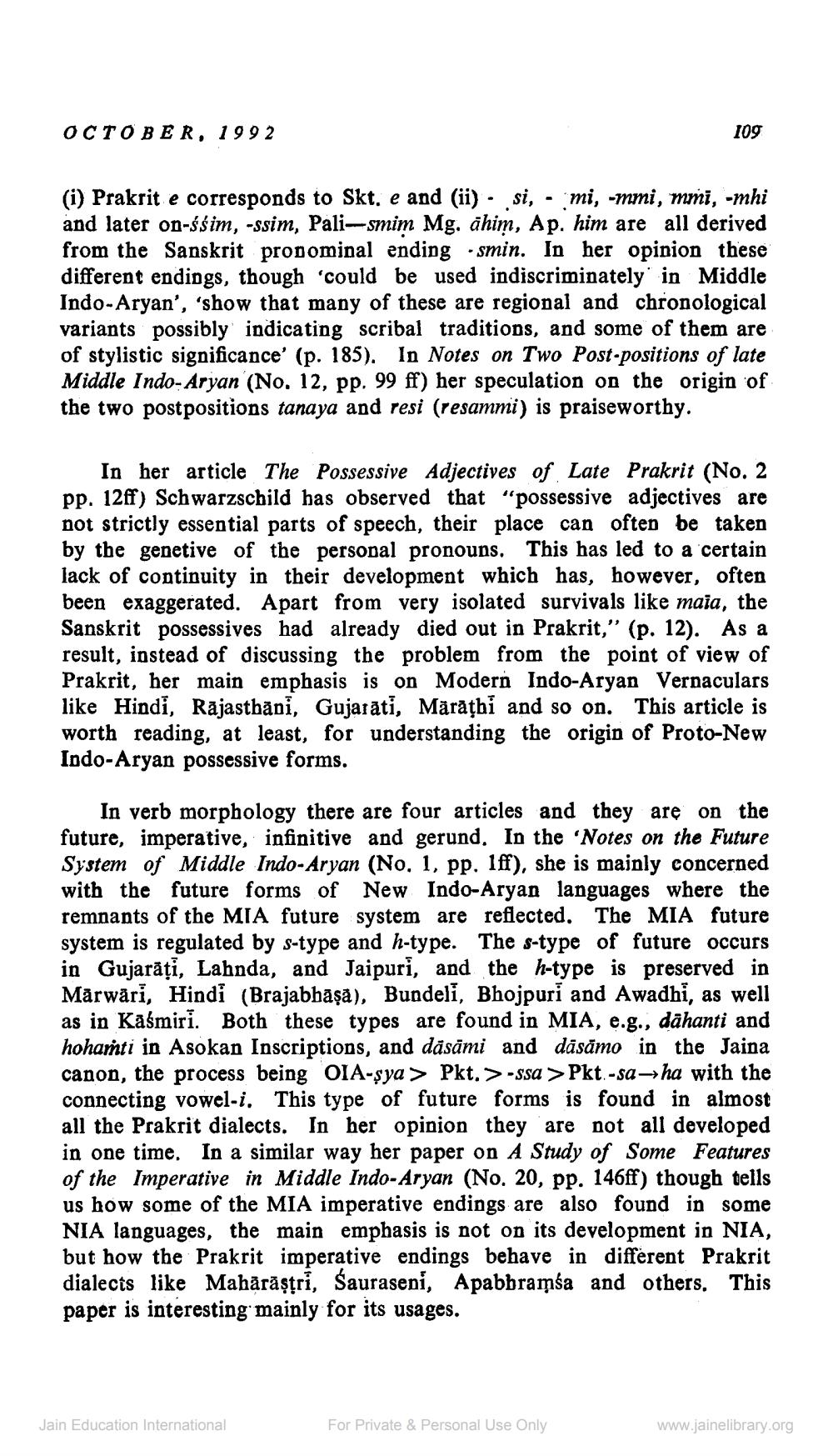Book Title: Jain Journal 1992 10 Author(s): Jain Bhawan Publication Publisher: Jain Bhawan Publication View full book textPage 7
________________ OCTOBER, 1992 (i) Prakrit e corresponds to Skt. e and (ii) si, - mi, -mmi, mmi, -mhi and later on-ssim, -ssim, Pali-smim Mg. āhim, Ap. him are all derived from the Sanskrit pronominal ending smin. In her opinion these different endings, though 'could be used indiscriminately in Middle Indo-Aryan', 'show that many of these are regional and chronological variants possibly indicating scribal traditions, and some of them are of stylistic significance' (p. 185). In Notes on Two Post-positions of late Middle Indo-Aryan (No. 12, pp. 99 ff) her speculation on the origin of the two postpositions tanaya and resi (resammi) is praiseworthy. 109 In her article The Possessive Adjectives of Late Prakrit (No. 2 pp. 12ff) Schwarzschild has observed that "possessive adjectives are not strictly essential parts of speech, their place can often be taken by the genetive of the personal pronouns. This has led to a certain lack of continuity in their development which has, however, often been exaggerated. Apart from very isolated survivals like maia, the Sanskrit possessives had already died out in Prakrit," (p. 12). As a result, instead of discussing the problem from the point of view of Prakrit, her main emphasis is on Modern Indo-Aryan Vernaculars like Hindi, Rajasthani, Gujarati, Marathi and so on. This article is worth reading, at least, for understanding the origin of Proto-New Indo-Aryan possessive forms. In verb morphology there are four articles and they are on the future, imperative, infinitive and gerund. In the 'Notes on the Future System of Middle Indo-Aryan (No. 1, pp. 1ff), she is mainly concerned with the future forms of New Indo-Aryan languages where the remnants of the MIA future system are reflected. The MIA future system is regulated by s-type and h-type. The s-type of future occurs in Gujarati, Lahnda, and Jaipuri, and the h-type is preserved in Marwari, Hindi (Brajabhāṣā), Bundeli, Bhojpuri and Awadhi, as well as in Kaśmiri. Both these types are found in MIA, e.g., dahanti and hohamti in Asokan Inscriptions, and dāsāmi and dāsāmo in the Jaina canon, the process being OIA-şya > Pkt. >-ssa > Pkt.-sa-ha with the connecting vowel-i. This type of future forms is found in almost all the Prakrit dialects. In her opinion they are not all developed in one time. In a similar way her paper on A Study of Some Features of the Imperative in Middle Indo-Aryan (No. 20, pp. 146ff) though tells us how some of the MIA imperative endings are also found in some NIA languages, the main emphasis is not on its development in NIA, but how the Prakrit imperative endings behave in different Prakrit dialects like Mahārāṣṭri, Śauraseni, Apabbramsa and others. This paper is interesting mainly for its usages. Jain Education International For Private & Personal Use Only www.jainelibrary.orgPage Navigation
1 ... 5 6 7 8 9 10 11 12 13 14 15 16 17 18 19 20 21 22 23 24 25 26 27 28 29 30 31 32 33 34 35 36 37 38 39 40 41 42 43 44 45 46 47 48 49 50 51 52 53 54 55 56 57 58 59 60 61 62 63 64
